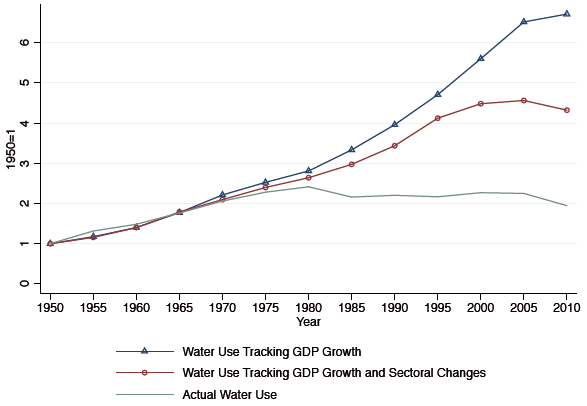The U.S. economy and population are growing. Our water use is not. New research by Peter Debaere and Amanda Kurzendoerfer of the University of Virginia helps further disentangle the reasons behind this remarkable U.S. water conservation success since the 1980s.
The break between population, economic growth, and water use is something Peter Gleick has pointed out before: “The assumption that demand for water must inevitably grow is false.”
Debaere and Kurzendoerfer have taken our understanding a step further by disentangling the roles of sectoral changes in our economy (has our core economy changed in a way that simply offshores our water use while we shift to doing other tasks that require less water?) versus underlying efficiency gains in the economy left behind:
The top line is their model of water use simply tracked GDP growth. The middle line is a “what if” it was simply “sectoral changes” in our economy – essentially offshoring our water use. The bottom line is what actually happened:
Technological improvements are responsible for the remainder of the water productivity gains–at least 50%. Since actual water is influenced by technological changes as well as structural shifts in the economy, the difference between the lowest line in Figure 1 (actual water use) and the second-highest one marks the contributions of technological improvements. The sizeable impact of technological improvement is a welcome finding if one considers technology an opportunity for replication abroad. Indeed, transferring technology can be a more actionable way of bringing about less water use, especially compared to the slow-moving process of structural shifts toward a less water-intensive service economy.


Interesting! Nice to read some good news every so often 🙂
The GDP track is primarily driven by whatever gallons per capita daily (gpcd) water planners assign to it. L.A. for example assigned 175 gpcd to it’s 1985 and 1990 plans. That fell dramatically in 1995 to 150 gcpd. I would like to say it is due to technologies and conservation but in reality planners couldn’t state with a straight-face that they could meet 850,000 Af/y demand if they held to the higher gpcd figure.
One other point, The ‘actual water use’ track doesn’t necessarily mean they are meeting demand. In L.A. this so-called ‘demand’ is actually a rising deficit that the city is responding to with increasingly onerous prohibitions on water use.